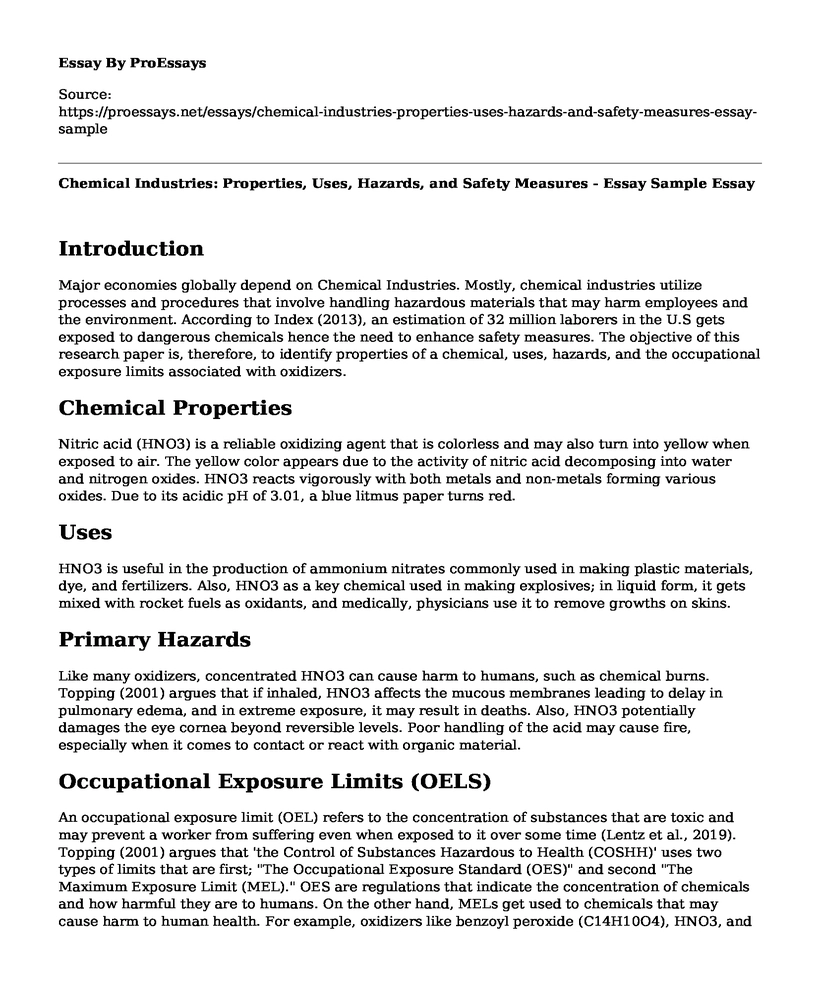Introduction
Major economies globally depend on Chemical Industries. Mostly, chemical industries utilize processes and procedures that involve handling hazardous materials that may harm employees and the environment. According to Index (2013), an estimation of 32 million laborers in the U.S gets exposed to dangerous chemicals hence the need to enhance safety measures. The objective of this research paper is, therefore, to identify properties of a chemical, uses, hazards, and the occupational exposure limits associated with oxidizers.
Chemical Properties
Nitric acid (HNO3) is a reliable oxidizing agent that is colorless and may also turn into yellow when exposed to air. The yellow color appears due to the activity of nitric acid decomposing into water and nitrogen oxides. HNO3 reacts vigorously with both metals and non-metals forming various oxides. Due to its acidic pH of 3.01, a blue litmus paper turns red.
Uses
HNO3 is useful in the production of ammonium nitrates commonly used in making plastic materials, dye, and fertilizers. Also, HNO3 as a key chemical used in making explosives; in liquid form, it gets mixed with rocket fuels as oxidants, and medically, physicians use it to remove growths on skins.
Primary Hazards
Like many oxidizers, concentrated HNO3 can cause harm to humans, such as chemical burns. Topping (2001) argues that if inhaled, HNO3 affects the mucous membranes leading to delay in pulmonary edema, and in extreme exposure, it may result in deaths. Also, HNO3 potentially damages the eye cornea beyond reversible levels. Poor handling of the acid may cause fire, especially when it comes to contact or react with organic material.
Occupational Exposure Limits (OELS)
An occupational exposure limit (OEL) refers to the concentration of substances that are toxic and may prevent a worker from suffering even when exposed to it over some time (Lentz et al., 2019). Topping (2001) argues that 'the Control of Substances Hazardous to Health (COSHH)' uses two types of limits that are first; "The Occupational Exposure Standard (OES)" and second "The Maximum Exposure Limit (MEL)." OES are regulations that indicate the concentration of chemicals and how harmful they are to humans. On the other hand, MELs get used to chemicals that may cause harm to human health. For example, oxidizers like benzoyl peroxide (C14H10O4), HNO3, and H2O2 follow the MELs requirements.
Process Safety Management (PSM) Requirements to Minimize Oxidizer Risks
The "Occupational Safety and Health Administration" (OSHA) establishes Process Safety Management (PSM) requirements (Cunio and Melhem, 2014). In this case, three essential conditions would apply to reduce the extent of risk when handling oxidant materials related to HNO3. First, it is of importance to ensure that employees get involved in the Programs of PSM at their respective working site. Secondly, managers should educate all the employees regarding the risks involved in handling HNO3. Also, managers should provide adequate information through signages and prints to remind workers of the dangers and critical areas in the working place. Thirdly, the manager should ensure that there is one employee skilled in the hazard methodology process to be used.
Importance of PSM
According to Osha, PSM requirements enhances the workflow at the workplace. In my view, PSM enables small businesses to follow PSM as the safety standards to minimize risks involved emanating from hazardous chemicals. The other importance of PSM relates to adequate training of employees to gets information about the potential consequences that one handles. As a result, caution prepares everybody to take care of handling critical points and harmful materials. Besides, employees learn about what to do incase an accident occurs in the process of handling hazardous substances.
References
Cunio, C., & Melhem, G. (2014). A Guide to the Legal Framework of the PSM Standard for Engineers. Process Safety Progress, 33(2), 152-155.
Index, C. P. (2013). The United States Department of Labor. Bureau of Labor Statistics.
Lentz, T. J., Seaton, M., Rane, P., Gilbert, S. J., McKernan, L. T., & Whittaker, C. (2019). Technical report: the NIOSH occupational exposure banding process for chemical risk management.
Topping, M. (2001). Occupational exposure limits for chemicals. Occupational and environmental medicine, 58(2), 138-144.
Cite this page
Chemical Industries: Properties, Uses, Hazards, and Safety Measures - Essay Sample. (2023, May 28). Retrieved from https://proessays.net/essays/chemical-industries-properties-uses-hazards-and-safety-measures-essay-sample
If you are the original author of this essay and no longer wish to have it published on the ProEssays website, please click below to request its removal:
- Mongolian Empire
- Compare and Contrast Essay Example: the Moon and Mars
- Linear Transformation and Road Function Paper Example
- The Properties of Life, Basic Chemical Terminology, and Molecules and Compounds of a Cell Necessary for Life
- Essay Sample on Origins of Earth's Oceans: 6 Billion Yrs Ago
- Essay Example on Dehydration of Cyclohexanol: E1 Reaction
- L-Rhamnose Degradation - Report Example







